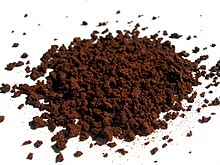Agglomerate (technology)
Agglomerate ( Latin : agglomerare - to bunch up, to pile up ) is the name given in technology to a more or less solidified accumulation of previously loose components to form a solid bond, which is produced by technical processes.
Technical agglomerate
In contrast to the conglomerate , the technical agglomerate has a more or less uniform granulate or grain size. In production, a general distinction is made between pressing and building agglomeration processes. Examples of press agglomeration are all tablet production processes. In contrast, there is build-up agglomeration. Examples include methods of making exploding paintballs for firecrackers. In the case of pigments (which are precipitated and dried during production), the term agglomerates is used when only corners and edges touch, but not surfaces. Unlike aggregates , pigment agglomerates can be comminuted when dispersed into the primary grains.
In metallurgy , the production of ceramics or plastics processing , agglomerates made of metallic , mineral or plastic powders are prepared by drying in a mold or by applying pressure and then joined together by heating below the melting point ( sintering ).
In the food industry , spray-dried, soluble powder coffee is converted into agglomeration coffee in a build-up agglomeration process.
In the production of corks as bottle closures from granulated cork, an agglomerate is produced by bonding with, for example, polyurethane. Similarly, in the production of cork mats, for example as a floor covering, cork granules are bonded with urea-formaldehyde resins to form an agglomerate.
